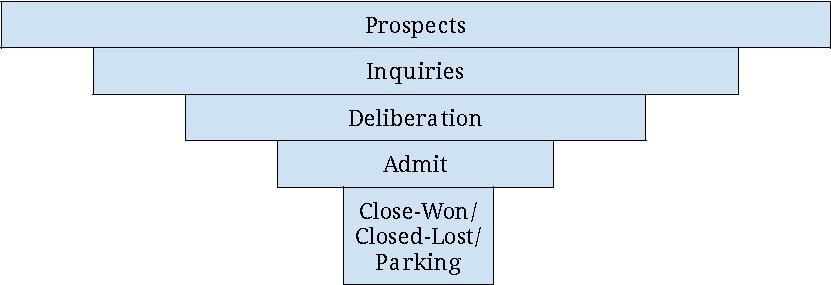The process-oriented funnel works well only if there is a proven and linear process that your customers follow to purchase a similar offering. If you have an innovative solution or are targeting prospects who have not encountered this solution before, you should not limit yourself to it. Instead, consider building what I call a User Journey Funnel.
This funnel should reflect the key decision-making stages, as outlined by the previously mentioned ACDC framework. Although it looks similar, it’s used in a completely different way. The Sales + Marketing Map helps us understand the various potential paths a prospect might take to convert. It allows us to meet them where they’re at through the right channels, with the right resources, and the appropriate CTAs. On the other hand, the User Journey Funnel is a live tool for tracking and visualizing your various prospects, allowing you to determine where each one is in the journey.
This approach better encourages SDRs to use different tools and actions instead of persistently trying to push a prospect to take the prescribed “next step” in their outlined process. For instance, not requiring prospects to jump on a demo call, but instead offering a trial to prospects who want to experience something first-hand.
Here’s what it might look like:

The terms you use to define the stages are up to you, the important thing is ensuring your team is aligned in their understanding of these definitions. Below is how I’ve defined this example:
Prospects: People whom I’ve identified as potentially a good fit for my program but haven’t yet displayed active interest (outbound, I typically need to guide them through the entire gradualization process).
Inquires (Awareness/Consideration): People who might be slightly interested and are trying to learn more. Might be an inbound lead or an outbound lead that has been converted to this stage.
Deliberation (Decision/Close): Expressing strong interest. High likelihood of converting these leads into a sale.
Admit: Verbally committed to signing up, but have yet to pay.
Close-Won: Cash in bank/Contract signed.
Close-Lost: Not interested.
Parking: Interested, but circle back later (e.g. Going away on vacation, no budget now, etc.)
Here’s a real albeit simplified example of gradualization applied to creating a User Journey Funnel for a program that helps entrepreneurs learn how to raise capital from investors.
Top of Funnel (ToFu)
| Realization #1: I need to scale. Goal: Make them realize that if they’re not growing, they’re dying. |
| Options: Ads, Meetups, Email Drips Potential Topics: • Analysis/reports showing growth trends for startups. • How to launch into new markets. • Navigating the recession. • How to go beyond early adopters and reach the mass market. • Metrics and signs to check to know if you’re ready to scale your business. |
| Capture email addresses to track intent, via: • Event registration page • Subscribe to newsletter • Download guide Track: Email responses/open rates/click-throughs |
Middle of Funnel (MoFu)
| Realizations #2: Funding will help me scale. #3: I don’t know anything about fundraising. #4: Your company is the expert in fundraising. #5: I need to start the process early to succeed. Goals: Show them the merits of raising capital vs. bootstrapping and build our credibility. |
| Options: Webinar, Workshop, Discovery call Potential Topics: • How to find your ideal investor. • Bootstrapping vs. Raising from investors. • Pitch workshop. • Valuation and dilution. • How to negotiate with investors. |
Bottom of Funnel (Bofu)
| Realization # 6: This program will save me time and money in raising my round. Goals: Familiarize them with the fundraising process and our program. Generate a sense of urgency (not a false one, but because fundraising takes a while, and most entrepreneurs have incorrect expectations about the timeline) |
| Options: Course Page, Interview, Demo Potential Topics: • Walk them through the fundraising process and timeline. • Review program curriculum and what’s expected of them vs. from us. • Discuss program pricing and emphasize that we do not collect commission on investor referrals nor do we seek equity for their participation. |
